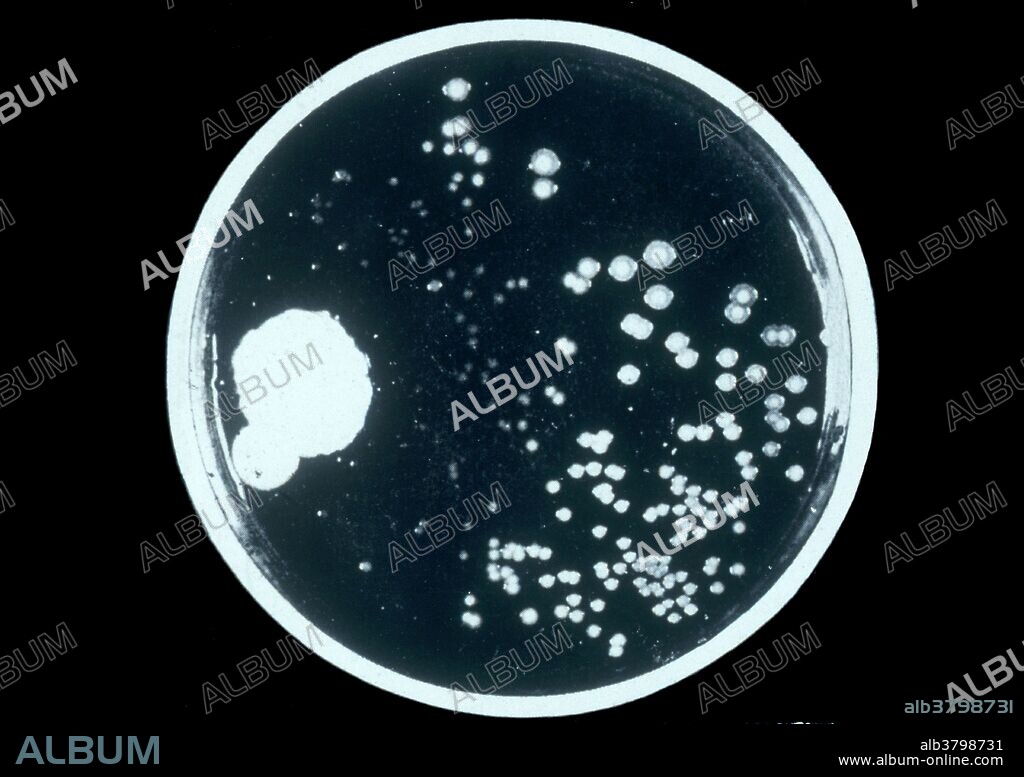alb3798731
Fleming's Penicillium notatum Culture Plate

|
Añadir a otro lightbox |
|
Añadir a otro lightbox |



¿Ya tienes cuenta? Iniciar sesión
¿No tienes cuenta? Regístrate
Compra esta imagen.
Selecciona el uso:

Título:
Fleming's Penicillium notatum Culture Plate
Descripción:
Traducción automática: Placa de cultivo original de Fleming del hongo Penicillium notatum, que condujo al descubrimiento del antibiótico penicilina. Alexander Fleming (6 de agosto de 1881 - 11 de marzo de 1955) fue un biólogo y farmacólogo escocés. Escribió numerosos artículos sobre la bacteriología, inmunología y quimioterapia. Sus descubrimientos más conocidos son el descubrimiento de la enzima lisozima en 1923 y la sustancia antibiótica penicilina del moho Penicillium notatum en 1928, por lo que compartió el Premio Nobel de Fisiología o Medicina en 1945 con Howard Florey y Ernst Boris Chain. El descubrimiento accidental y el aislamiento de la penicilina por parte de Fleming marcaron el inicio de los antibióticos modernos. También descubrió que las bacterias desarrollaban resistencia a los antibióticos cuando se usaba muy poca penicilina o cuando se usaba por un período demasiado corto. Almroth Wright había predicho la resistencia a los antibióticos incluso antes de que se notara durante los experimentos. Fleming advirtió sobre el uso de la penicilina en sus numerosos discursos alrededor del mundo. En 1999, la revista Time nombró a Fleming una de las 100 personas más importantes del siglo XX. Murió en 1955 de un infarto a la edad de 73 años.
Fleming's original culture plate of the fungus Penicillium notatum, which led to the discovery of the antibiotic penicillin. Alexander Fleming (August 6, 1881 - March 11, 1955) was a Scottish biologist and pharmacologist. He wrote many articles on bacteriology, immunology, and chemotherapy. His best-known discoveries are the discovery of the enzyme lysozyme in 1923 and the antibiotic substance penicillin from the mold Penicillium notatum in 1928, for which he shared the Nobel Prize in Physiology or Medicine in 1945 with Howard Florey and Ernst Boris Chain. Fleming's accidental discovery and isolation of penicillin marked the start of modern antibiotics. He also discovered that bacteria developed antibiotic resistance whenever too little penicillin was used or when it was used for too short a period. Almroth Wright had predicted antibiotic resistance even before it was noticed during experiments. Fleming cautioned about the use of penicillin in his many speeches around the world. In 1999, Time magazine named Fleming one of the 100 Most Important People of the 20th Century. He died in 1955 from a heart attack at the age of 73.
Crédito:
Album / Science Source
Autorizaciones:
Tamaño imagen:
4800 x 3396 px | 46.6 MB
Tamaño impresión:
40.6 x 28.8 cm | 16.0 x 11.3 in (300 dpi)
Palabras clave:
1881 • 1955 • BRITANICO • CIENCIA • CULTURA • DESCUBRIMIENTO • ESCOCÉS • ESTAFILOCOCO • EUROPEA • EUROPEAS • EUROPEO • EUROPEOS • FAMOSA • FAMOSO • FAMOSOS • FARMACÓLOGO • FIGURA • FLEMING • FOTO • FOTOGRAFIA • GANADOR DEL PREMIO NOBEL • GENTE • HISTORIA • HISTORICO • HOMBRE • HOMBRES • IMPORTANTE • INMUNOLOGO • INVESTIGACION • MASCULINO • MEDICINA • MEDICINAL • NOBEL • PATOLOGIA • PENICILLIUM NOTATUM • PENICILLIUM • PERSONA • PERSONALIDAD • PERSONALIDADES • PETRI • PLACA DE PETRI • PREMIO NOBEL • RETRATO DE HOMBRE • S. XX • SIGLO XX • SIR


 Pinterest
Pinterest Twitter
Twitter Facebook
Facebook Copiar enlace
Copiar enlace Email
Email
